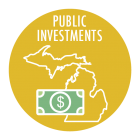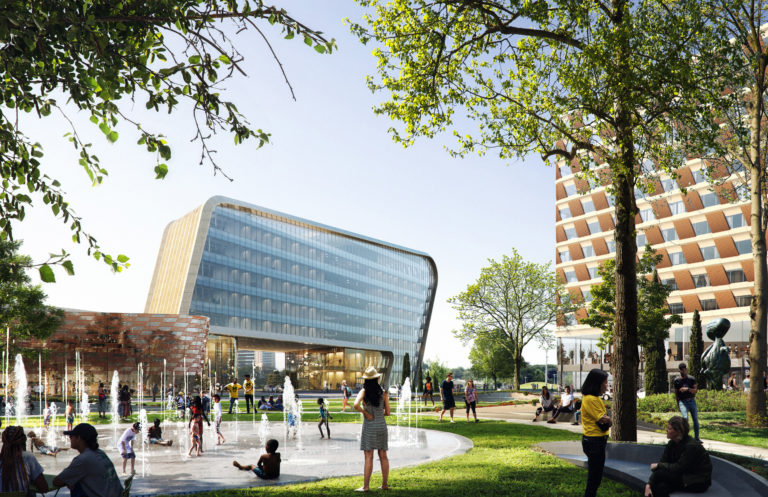
Crain’s Chad Livengood begins his story on the new University of Michigan Detroit Center for Innovation this way:
Across the Potomac River from the nation’s capital, Virginia Tech is developing a 1 million-square-foot innovation campus in Alexandria, Va., that’s two Metro commuter train stops away from the second North American headquarters Amazon is building.
In New York City, Cornell University’s tech campus on Roosevelt Island has positioned the prestigious upstate New York school as an urban university across the East River from Long Island City, where Amazon planned to build another headquarters.Manhattan real estate developer Stephen Ross points to these two strategic locations for world-class universities as the reason why he believes his alma mater, the University of Michigan, needs to have a significant footprint in downtown Detroit.
“Corporations go to urban areas because of the talent they generate,” Ross said in an exclusive interview with Crain’s. “When Amazon was going to come to New York, it was because of Cornell Tech and the students that it was generating for senior management. … So there’s a lot of lessons to be drawn.”
The main lesson Ross has learned is that cities and universities are now the primary drivers of economic growth. They are the keys to growing, retaining and attracting high-wage, knowledge-based enterprises. This is a talent-driven economy. The cities that combine the universities where talent is being developed and the high-density, high-amenity neighborhoods where young talent wants to live and work are the most prosperous places.
In 2012 we wrote a post on the Cornell University campus Ross mentions. Unfortunately its conclusions are still relevant today. Michigan policymakers still, by and large, do not understand that public investments in cities and higher education are the drivers of economic growth. Lightly edited here is that 2012 post:
The elected official in America today who is most aggressively pursuing positioning his community for a knowledge-driven economy is New York City Mayor Michael Bloomberg. He inherited a city already with many assets for that economy: an entrepreneurial culture, a city that is welcoming to all, as well as great public services and amenities that make NYC a place where mobile talent wants to live and work. To his credit Mayor Bloomberg is pushing to enhance those assets.
Unlike many, when the economy collapsed at the onset of the Great Recession he raised taxes (yes raised, not cut taxes) to make sure that the city could maintain quality basic services and amenities. He has been an innovator in improving schools, a national voice for pro-immigration policies and an investor in infrastructure, parks and the arts all of which enhance NYC as a place that can compete globally for talent.
But maybe his biggest and most impactful action has been to sponsor a competition to lure a brand new engineering and technology higher education campus to the city. Talk about outside the box and making a big bet! A mayor getting involved in funding higher education. But Bloomberg understands that higher education––particularly research universities––are a critical economic driver in a knowledge-driven economy. Quite simply you want to be the place where new knowledge is being created and new talent is being prepared. The city offered as an incentive land as well as $100 million in infrastructure improvements.
The New York Times reports that Cornell University in partnership with Technion-Israel Institute of Technology won the competition over such prestigious competitors as Stanford, Columbia and Carnegie Mellon. According to the Times the plan calls for about 280 faculty members and 2,500 students in master’s and doctoral programs. The schools have also committed to training at least 200 teachers each year in science education, and to help teach at least 10,000 students, from kindergarten through 12th grade, each year. The initiative includes a $150 million venture capital fund for start-up companies that agree to remain in New York for three years, as well as math and science education support for 10,000 city children. They estimated that building the campus would create 20,000 construction jobs, and that it would spin off 600 new businesses over the next generation, creating 30,000 more jobs and as much as $1.4 billion in tax revenue.
Contrast that to Michigan’s approach to higher education the last decade. Cutting spending by nearly a third, imposing price controls and increasingly micro-managing from Lansing how universities operate. I’m sure there wasn’t anything in the NYC competition that asked universities about whether they offer domestic partner benefits, or placed conditions/restrictions on stem cell research, or affirmative action restrictions or whether or not they have tenured professors who are not teaching full time or placed limits on the tuition they charge. All misguided obsessions here.
This competition is not just about how a state or city value higher education––as a powerful asset for economic growth or wasteful spending institutions that need to be reined in. It is also about whether there are essential assets that matter to economic growth that communities need to invest in whether times are tough or not to be globally competitive. Mayor Bloomberg’s higher education play is entirely consistent with Denver in the 80s, when its economy collapsed, deciding that to be globally competitive they needed a world class airport and Portland in the 70s and Salt Lake City in the 90s deciding that to be competitive they needed rail transit or California in the 50s committing themselves to building a comprehensive, world-class higher education system. The list goes on and on. The lesson is clear: public investments in strategic assets are essential to globally competitive states and regions.
Once again contrast that list of impactful public investments to what is happening here. Where we are letting our roads crumble, walking away from the Woodward light rail even with private investors putting $100 million on the table, weakening what was once one of the great higher education systems on the planet, etc. Ask yourself “who is positioning themselves best to win in a flattening world, those who make big strategic public investments or those––like us––who don’t?”







